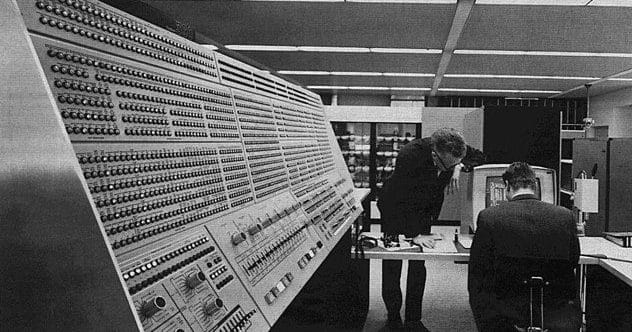When we think about modern computers, our minds often jump to how quickly technology changes. It feels like a new laptop or smartphone is almost outdated the moment we open the box. Fresh features, faster speeds, and more storage seem to pop up constantly.
So, it might surprise you to learn just how old some of the tech we rely on every day actually is. From operating systems and programming languages created decades ago to network protocols that have been around for ages, parts of our tech-filled world are surprisingly vintage. And they’re not disappearing anytime soon. Let’s explore ten examples of very old computing technology that are still widely used today.
1. The OS That’s Half a Century Old: Unix
Remember the line, “It’s a Unix system! I know this!” from the 1993 movie Jurassic Park? It became an internet sensation, and for good reason. Many tech professionals can relate. If you understand the Unix operating system, you can comfortably use almost any Unix-like system made in the last 50 years.
Unix began its journey at AT&T’s Bell Labs back in 1969. It was designed from the start as a system that could handle multiple tasks and multiple users at once. Unix has always been praised for its smart design and dependable stability. But what truly keeps users loyal is the “Unix philosophy.” This is a set of design ideas that favors small, effective applications that can easily share data with others.
While AT&T sold Unix licenses for many years, its core ideas led to many Unix-like systems. Today, developers can get their operating systems certified as a “UNIX-Certified Product.” In the world of free and open_source software, Linux distributions are the most popular, and Linux is considered Unix-like. Linux powers a huge number of internet servers and is also making its way onto desktop computers. It’s amazing to think how long Unix and systems like it have been around and how important they still are.
2. The Ancient Coding Language Banks Can’t Quit: COBOL
When programmers talk about coding languages today, you’ll often hear names like Go, Rust, and C#. However, there’s a programming language that’s been heavily used since it first appeared in 1959. This language, COBOL, continues to be the foundation for global finance.
COBOL came about because businesses and the U.S. government needed a common language. They wanted something that could run on different mainframes of that era and use simple, English-like commands. After COBOL was finished in late 1959, banks, stock brokerages, and government agencies like the IRS quickly adopted it.
Even though the tech world loves the newest thing, COBOL has stayed the standard in financial industries. Surprisingly, there’s been a shortage of COBOL programmers for years. Younger coders usually learn and focus on newer languages. Banks and government agencies keep postponing plans to move away from COBOL because retiring these old systems is expensive and complicated. This means our financial systems still depend on a language that’s now over 60 years old!
3. The Super Popular (and Super Old) Coding Tool: Vim
Most computer users write text in word processors. Programmers, however, use plain text editors. Plain text is simple; it doesn’t have the fancy formatting like different fonts or text alignment that you see in word processors. Since computers read code written in plain text, coders need a good editor to write and edit it efficiently.
Many popular plain text editors today are actually IDEs (integrated development environments). These help manage all the files in a project and track code changes. Microsoft’s Visual Studio Code is a top choice now. But the minimalist yet powerful editor Vim is still a favorite among coders, which is amazing given its age.
Vim itself was released in 1991, but its history goes back much further. The Unix app vi (short for “visual”) came out in 1979 and was an update of an even older tool. Vim appeared a couple of decades after vi. Its name originally meant “vi imitation,” but now stands for “vi improved.”
A first glance at Vim might seem intimidating. It looks like a screen of text with no visible menus or controls. But its power lies in its modes: Insert mode lets you type text, while Normal mode lets you run commands on your text. Normal mode is the secret weapon, allowing quick copying, pasting, and other text changes without ever taking your fingers off the keyboard. This speed and power have kept Vim popular, even though its roots trace back to the creation of Unix in 1969.
4. Steve Jobs’s Misstep, Reborn: NeXTSTEP
It’s a famous story in business: Steve Jobs was forced out of Apple in 1985. He then used $12 million of his own money to start a new computer company called NeXT. In 1989, NeXT launched its first product, the NeXT Cube. It was a beautifully designed but very expensive workstation computer. It was too pricey for most universities and researchers—Jobs’s target market—and way too expensive for home users. NeXT became known as a high-profile failure.
However, those who did buy a NeXT computer loved its operating system, NeXTSTEP. Built on a Unix core, NeXTSTEP was powerful, flexible, and stable in a way other operating systems of the time weren’t. When Apple needed a new OS for their Macs, they bought NeXT in 1997 for $429 million. This deal gave Apple the rights to NeXTSTEP and brought Jobs back to the company.
Apple’s rise to become one of the world’s most successful companies is well-known. But NeXTSTEP’s role in that success is often overlooked. It was first adapted as Mac OS X for desktops and laptops. It’s also the foundation for iOS on iPhones, iPadOS, and even TV OS on Apple TV boxes. Though it goes by different names now, NeXTSTEP’s 30-plus years make it one of the oldest operating systems still being actively developed today.
5. The Go-To for Downloading Files: ZIP
If you’ve ever downloaded files from the internet or shared them, you’ve likely encountered ZIP files. But what are they? Technically, ZIP is a compression format. This means it takes an existing file and makes it smaller. When the ZIP file gets to its destination, it can be decompressed to return the file to its original state. This not only saves storage space but also helps files transfer more quickly over networks and reduces the chance of corruption. Many other compression formats exist, but ZIP has outlasted them all. It’s pretty incredible, considering the format is now in its fourth decade of use.
Created by programmer Phil Katz at his company PKware in 1989, the ZIP file format actually came before the modern internet. Back in the 1980s, hard drive space was very expensive, so ZIP was one of many compression tools. But its ease of use and its widespread availability across almost all computer platforms have made ZIP the standard for file compression ever since.
Another reason for ZIP’s long life is its usefulness in general file handling. Microsoft’s standard Office file formats (like DOCX for Word and XLSX for Excel) are actually ZIP files under the surface. This allows Microsoft to essentially bundle several different files into what looks like a single file, making them compatible with other office applications.
6. The Giants of Computing’s Past, Still Here: Mainframes
When we think about computer history, it’s common to picture giant mainframes that filled entire rooms, eventually shrinking down to desktop computers and handheld devices. But the truth is, mainframes are still with us. They continue to perform vital business functions for companies all over the world. A 2021 survey showed that 67 of the Fortune 100 companies still use mainframes.
Mainframes got their name from the large cabinets that housed the CPU and main memory—the “main frame.” While today’s mainframes share the same basic structure and size as their mid-20th century ancestors, their computing power has definitely increased. What hasn’t changed is their reliability in processing many transactions per second, a hallmark of mainframes.
And in today’s computing world, mainframes are learning new tricks. Besides running old systems like COBOL applications, modern mainframes provide the backbone for cloud computing and can run multiple virtual machines at the same time. Far from being just relics of the past, mainframes are actually a key part of our tech-driven world today.
7. The Point-and-Click Pioneer That Stuck Around: Computer Mouse
It’s hard to imagine computing without some kind of keyboard, whether for typing or giving commands to the computer. And by now, it’s safe to say the computer mouse is here to stay too.
The first prototype mouse was created in 1964 by Douglas Engelbart. At the time, he was a Director at the Augmentation Research Center at Stanford Research Institute. But the mouse truly entered mainstream culture in 1979. That’s when a group of Apple engineers and executives, led by Steve Jobs, visited the Xerox Palo Alto Research Center (PARC).
On this trip, Jobs saw computers with icons, windows, a mouse, and other technologies developed at PARC. Convinced (and he was right!) that this was the future of personal computing, Jobs took this knowledge back to Apple. By 1983, Apple had launched its first computer with a mouse, the Lisa, followed by the first Macintosh in 1984.
Since then, the mouse has become an essential part of personal computing. Not bad for a piece of hardware designed in the 1960s! Apart from some technical improvements and ergonomic tweaks, it’s more or less the same device we use in the 21st century.
8. The Foundation of Modern Networks: Ethernet
Another breakthrough from Xerox PARC—which Steve Jobs admitted he completely missed during his 1979 visit—was a group of personal computers networked together. This setup allowed them to share files and resources like printers. It’s something we take for granted today, especially with the giant worldwide network known as “The Internet.” But it was all made possible thanks to Ethernet.
Bob Metcalfe invented Ethernet in 1973 at Xerox PARC. The company patented it in 1975, and it later became an open standard. For wired network connections, Ethernet is the undisputed standard. This isn’t because there haven’t been other options over the years. Competing technologies like Token Ring, FDDI, and Apple’s LocalTalk all vied with Ethernet at various times over the last five decades. Yet, Ethernet has remained the top choice.
But what about WiFi? It was actually created as a wireless version of Ethernet. Its official name as a recognized standard is, in fact, “wireless Ethernet 802.11.” So, while Ethernet has gotten faster and gone wireless over time, it’s essentially the same concept today as what Metcalfe developed in the 1970s.
9. The Internet’s Building Blocks, Older Than the Web: TCP/IP
You’ve probably seen your computer’s TCP/IP settings at some point, but what exactly is it? To put it simply, it’s complicated and best left to network engineers. But from a high-level view, TCP stands for Transmission Control Program, which controls how data travels over the internet. The Internet Protocol (IP) defines your address on the internet and how data is routed to you. What’s most interesting about these two is that they were developed years before the public internet emerged in the 1990s.
The forerunner to the public internet was ARPANET, created by the Advanced Research Projects Agency (ARPA) of the United States Department of Defense. It turns out TCP/IP was developed and refined there throughout the 1970s and 1980s. Two men, Robert E. Kahn and Vinton Cerf, are credited as the forefathers of these protocols. In reality, it was a work in progress. TCP first replaced earlier protocols in 1974. Kahn and Cerf later realized that the network’s growth wasn’t possible without separating addressing and routing into a distinct protocol. Thus, in 1983, the Internet Protocol was created. TCP/IP as we know it today was now in place.
If not for the groundwork done on ARPANET, the internet wouldn’t have been ready for the public in the 1990s. The work of Kahn and Cerf might seem ancient in technology terms, but thankfully, it has proven strong enough to scale up to the massive global network we use daily.
10. As Old as Networks Themselves: Email
Even though many of us dread checking our email inboxes—often full of spam, promotional offers, and more tasks—it’s still a vital part of daily computing. If you don’t love email now, try to imagine how exciting it must have been in its early days. Sending a message across computers probably seemed like something from a science fiction movie!
Not surprisingly, ARPANET was the network that hosted the first email delivery. On October 29, 1969, UCLA professor Leonard Kleinrock and his student programmer Charley Kline attempted to send a message over ARPANET. Their recipient was another programmer, Bill Duvall, at Stanford Research Institute. The message was intended to be one word: “login.” But the system crashed right after they typed the “o”!
Thankfully, they successfully sent the full message about an hour later, and that marked the birth of email. Was it a good thing? That’s for each of us to decide. But considering how long email has been around and the billions of messages sent since 1969, it’s definitely noteworthy. One of the oldest computer technologies is still a fundamental part of our everyday lives.
These enduring technologies show that sometimes, the old ways stick around for a reason. They were built on solid foundations, solved fundamental problems, and have adapted over time. It’s a fascinating reminder that not everything shiny and new replaces the tried and true.
What other vintage tech do you still use or admire? Share your thoughts in the comments below!










